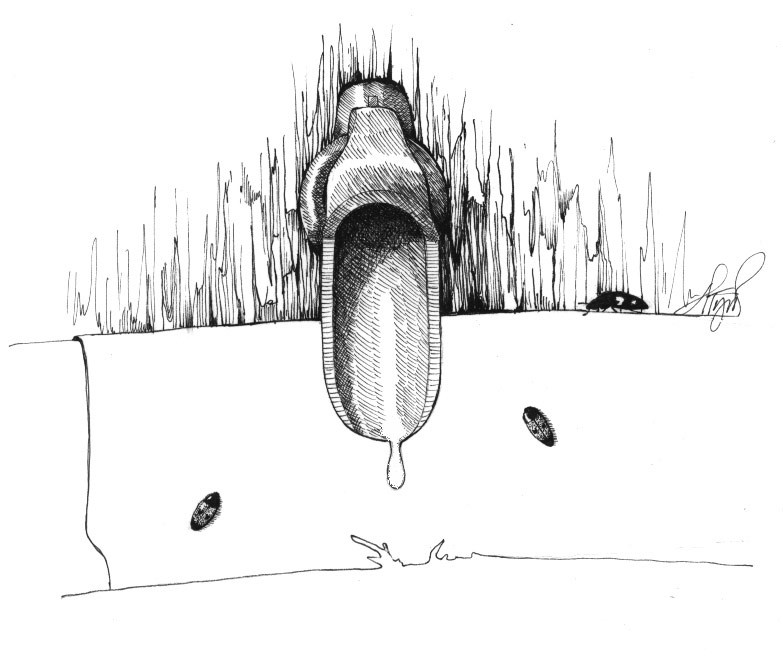
Moths in the sap bucket! To the sugarmaker, this sight signals the winding down of the sugaring season. But to entomologists, it means that it’s time for insects and entomologists to meet again, released as they both are from a pent-up winter. Field biologists who track moths know that a bait of sugar (or maybe fermenting fruit and molasses, perhaps with a bit of beer or rum thrown in) will lure in a wonderful array of moths. It’s no surprise, then, that the sap from maple trees, especially as it starts to ferment in sap buckets in warmer weather, is attractive to insects.
Of the more than 2,000 known species of moths in Vermont, at least a couple of dozen – and possibly many more – are attracted to sugar maple sap. Unfortunately, the specimens we see are often in such a waterlogged condition that identification is difficult. Most belong to the family Noctuidae, from the Latin noctua, which means owl. The eyes of many noctuids shine brightly and look large when light strikes them, bringing to mind the appearance of owls.
The noctuid moths that show up in sap buckets have spent the winter months as adults, hiding under bark, amidst the leaf litter, and in other safe places. As temperatures rise and days lengthen, these moths cease hibernation and emerge ready to feed, which they need to do before they mate and lay eggs. Keep your eyes open, in particular, for the moths we call sallows and quakers. (A good field guide is essential here.) Also look for Grote’s pinion and for the dot-and-dash swordgrass moth; individuals are sometimes the worse for wear from overwintering, but if you can find a specimen that is dry and fairly intact, you’ll appreciate the complex brown, cream, and gray patterns of these moths.
Deliberate baiting, also called “sugaring” by its fans, can attract many hundreds of moths on a given night to a small number of treated trees. Best done on warmer evenings as patches of open forest ground grow larger, baiting can be continued for several weeks. Moth numbers then drop off quickly at the bait stations, as the subsequent blooming of red maple provides a much more abundant source of food.
But moths aren’t the only insects with a sweet tooth. Various beetles and flies, and even occasional “blooms” of springtails, frequent the sugarbush. The familiar, lanternless dusky firefly, a cousin of the winking, blinking species of summer evenings, is one of the beetles that is often found floating in a sap bucket, hanging on a spout, or paddling in a collecting tank. If you get a close look at the adult beetle, you’ll see a shield that covers its head – a sort of insect hardhat. The larval form of the dusky firefly is reminiscent of an armadillo, with charcoal gray plate-like shields covering its body. Its pink “undershirt” suggests that the larva is wearing a colorful cummerbund beneath the armor. But you will only find the adults in the sap bucket – the larvae pupate in dead logs and won’t emerge as adults until the autumn.
Other beetles that are lured to sap include members of the family Nitidulidae. Commonly known as “sap beetles,” this group enjoys a reputation for having one of the largest feeding repertoires of all beetles. Many feed on decaying or fermenting plant tissue and are associated with yeast and other fungi that cause fermentation in tree wounds.
An friend of mine who has been recording species that show up in his sap buckets each spring has noted four closely-related species of sap beetle. These beetles, known variously as “picnic beetles” or “beer bugs,” depending on how you spend your days off, occur most commonly in rancid sap or under fermenting bark and feed on decaying fruits and fermenting plant juices.
Another two-legged sugarmaker whose industry attracts insects is one of our earliest spring migrants, the yellow-bellied sapsucker. The sap that oozes from those familiar rows of holes drilled by this veritable tapping fool sets the table for an assortment of insects as well as many foraging birds, including hummingbirds, which enjoy both the insects and sap.
W. J. Holland, the lepidopterist who in 1903 published The Moth Book, seemed particularly taken with the pleasures of sugaring as a means of observing moths. He wrote, “The task is accomplished! Forty trees and ten stumps have been baptized with sugar-sweetened beer. Let us wash our sticky fingers in the brook and dry them with our handkerchiefs. Let us sit down….beneath this tree and puff a good Havana.”

